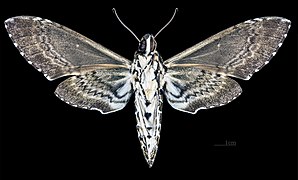Manduca rustica
| Manduca rustica | ||||||||||||
|---|---|---|---|---|---|---|---|---|---|---|---|---|

Manduca rustica |
||||||||||||
| Systematics | ||||||||||||
|
||||||||||||
| Scientific name | ||||||||||||
| Manduca rustica | ||||||||||||
| ( Fabricius , 1775) |
Manduca rustica is a butterfly ( moth ) from the family of moth (Sphingidae).
features
The moths have a fore wing length of 52 to 69 millimeters. With its dark chocolate-brown basic color and the striking white pattern on both pairs of wings, the species differs significantly from the other species of the genus Manduca . There is a certain similarity to Manduca albiplaga , which, however, is larger and has conspicuous white scales on the head. The species also wears a conspicuous white band on the first abdominal segment. The pattern of Manduca rustica is only slightly variable in the intensity of the white scales.
The caterpillars are easy to identify due to their size, the seven pairs of oblique, purple side stripes and the long, grainy anal horn .
The pupa is very dark brown and has a free sheath that ends in a strong thickening. The short, wide Kremaster ends in a blunt double point.
Occurrence
The species is predominantly neotropical , but also colonizes a number of states in the United States. The species has its northernmost distribution in Delaware , with the distribution extending to the west over the lower Mississippi valley. Manduca rustica can be common in Texas , southern New Mexico and Arizona, and southern California . In late summer and early autumn it can be detected as a stray visitor to southern Québec , southwestern Ontario and southeastern Manitoba . The southern distribution extends over Mexico and Central America south to Uruguay .
Manduca rustica inhabits different habitats. They are found in forests in the east of the United States and on bodies of water and alluvial land in the southwest. The very adaptable species can also be found in urban areas.
Way of life
The moths fly to artificial light sources and can be observed in the evening when they visit flowers, for example on Agave parryi , Datura meteloides , Vinca rosea , Saponaria officinalis or even on the ripe fruits of Stenocereus thurberi .
Flight and caterpillar times
In the southwestern United States, the moths are found in several generations from May to October, in Arizona they fly in one generation during summer rains. Otherwise, the species flies in the north of its distribution in two generations from July to November. In Costa Rica they fly all year round, with a maximum in May and June. In Bolivia, the species has been recorded from January to April, June, October and December.
Food of the caterpillars
The caterpillars feed on a number of plants from different families. Mainly they feed on trumpet trees (Bignoniaceae), such as Chilopsis linearis , Tecoma stans or Tecomaria capensis . They are also often found on verbena plants (Verbenaceae) such as Lantana camara , Callicarpa americana and some Aloysia species. They have been found less often on ash trees ( Fraxinus ), holly trees ( Ilex ) and some types of cordia ( Cordia ). In Costa Rica the caterpillars feed on a very wide range of plant families.
development
The females lay their eggs on both sides of the leaves of the host plants. The caterpillars stay on the underside of the leaves during the resting phases, but eat sitting freely on the upper side. The diurnal caterpillars are well camouflaged by their color. The caterpillars, ready to pupate, bury themselves several centimeters deep in the ground and pupate in a chamber with strongly solidified walls.
supporting documents
Individual evidence
- ↑ a b c d e f g h i James P. Tuttle: The Hawkmoths of North America, A Natural History Study of the Sphingidae of the United States and Canada. The Wedge Entomological Research Foundation, Washington, DC 2007, ISBN 978-0-9796633-0-7 .
- ↑ a b Sphingidae of the Americas. Bill Oehlke, accessed December 17, 2011 .
literature
- James P. Tuttle: The Hawkmoths of North America, A Natural History Study of the Sphingidae of the United States and Canada. The Wedge Entomological Research Foundation, Washington, DC 2007, ISBN 978-0-9796633-0-7 .






